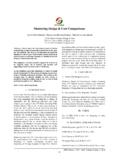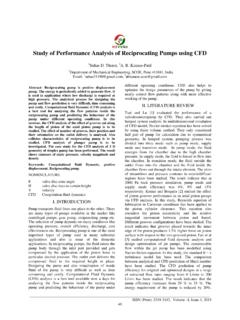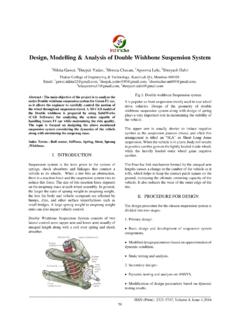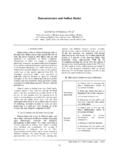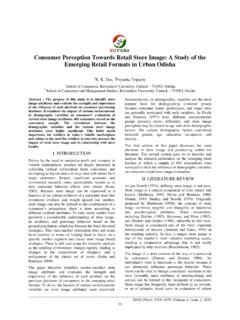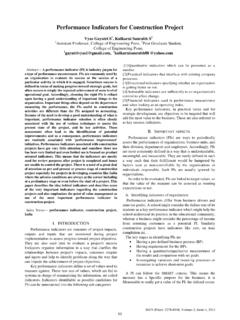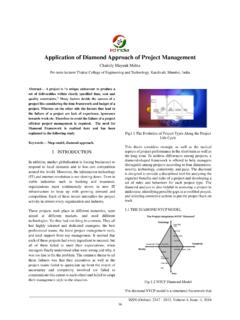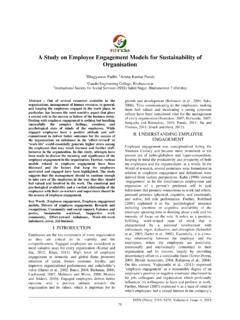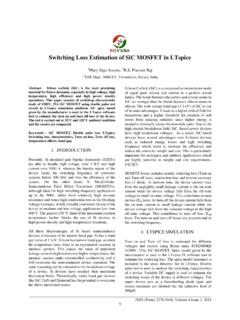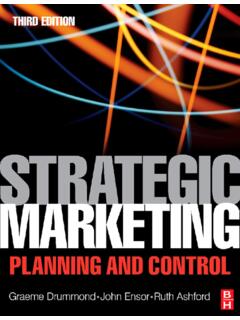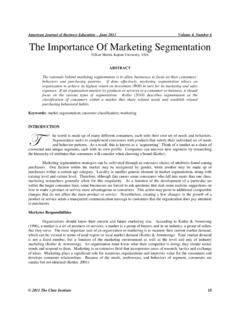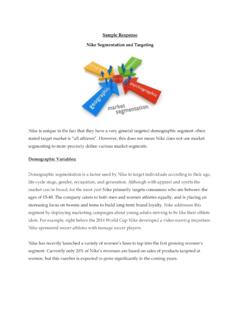Transcription of A Study on the Product Life Cycle of Samsung Smartphone’s ...
1 A Study on the Product life Cycle of Samsung Smartphone s in India _____ _____ National Seminar on Emerging Trends in Management & Information Technology (ETM&IT-2016) ISBN. 978-93-81692-07-2, Rourkela Institute of Management Studies, Rourkela, 20th February, 2016 41 A Study on the Product life Cycle of Samsung Smartphone s in India Dibyajyoti Mohapatra Asst. Prof. Marketing Management, Srusti Academy of Management, Bhubaneswar Abstract : This Mini Project is about a Study on the Product life Cycle of Samsung Galaxy in India and the marketing strategy it has used for its smart devices in the Smartphone market . The project will look into products introduced within the last two years, its mission and goals and some of the key challenges it faces today. Then it will continue in exploring the marketing mix of Samsung Smartphone in their introduction stages, to have a deeper understanding on how Samsung has differentiate itself using the four components of the marketing mix to gain an advantage over its components.
2 Further we will see how Samsung recognizes every need in the market and how it offers products for different customer segment. Samsung s successful growth strategy in mobile phone business. Keywords : Product , Product life Cycle , segmentation (types), Features, Popularity, Competitors. I. INTRODUCTION When a new Product is being introduced in to a market , it normally undergoes a series of step in the market ; these steps are introduction growth, maturity and lastly the decline stage. These steps follow each other chronologically and thus referred to as the Product life Cycle (PLC). The PLC sequence or series is closely linked with the dynamics in the market environment and has subsequent effects on the Product marketing mix and marketing strategies. Marketing is about creating markets by satisfying target customers needs and wants better than competitors.
3 Marketing is all about Product , the Product is a bundle of satisfaction that a customer buys. The marketing definition of a Product is more than just what the manufacturer understands it to be. In this industry, of fierce competition, the companies have been forced to come up with very creative technological innovation and winning marketing strategies. When iPhone was launched by Apple Inc. in 2007, they created the Smartphone market for the average consumers, before that the Product was targeting only business users. From then Apples' iPhone and Android phones, which are offered by Samsung , HTC and Nokia have tried their best in competing in this ever changing high-tech market and so far have qualified to be the big players in the Smartphone industry. OBJECTIVE OF THE Study To Study the PLC To Study the segmentation To Study the PLC of Samsung Galaxy To know the top brands To Study the issues/challenges II.
4 Product According to Peter Drucker, so long as a Product is not brought and consumed, it remains a raw material or at best an intermediate. The Product is almost always a combination of tangible and intangible benefits. For example, a refrigerator is not just merely steel, plastic, Freon gas, brand name, number of doors and so on, but also involves factors like after sales service, delivery and installation, assistances in purchase of the Product , dealer network, and services. It also connotes status in developing countries. It is the same with products like TV, music system, automobiles, personal Product , and services like banks, airlines, telephone, courier, and so on. III. Product life Cycle As consumers, we buy millions of products every year. And just like us, these products have a life Cycle . Older, long-established products eventually become less popular, while in contrast, the demand for new, more modern goods usually increases quite rapidly after they are launched.
5 Because most companies understand the different Product life Cycle stages, and that the products they sell all have a limited lifespan, the majority of them will invest heavily in new Product development in order to make sure that their businesses continue to grow. Product life Cycle Stages Explained The Product life Cycle has 4 very clearly defined stages, each with its own characteristics that mean different things for business that are trying to manage the life Cycle of their particular products. a. Introduction Stage This stage of the Cycle could be the most expensive for a company launching a new Product . The size of the market for the Product is A Study on the Product life Cycle of Samsung Smartphone s in India _____ _____ National Seminar on Emerging Trends in Management & Information Technology (ETM&IT-2016) ISBN. 978-93-81692-07-2, Rourkela Institute of Management Studies, Rourkela, 20th February, 2016 42 small, which means sales are low, although they will be increasing.
6 On the other hand, the cost of things like research and development, consumer testing, and the marketing needed to launch the Product can be very high, especially if it s a competitive sector. b. Growth Stage The growth stage is typically characterized by a strong growth in sales and profits, and because the company can start to benefit from economies of scale in production, the profit margins, as well as the overall amount of profit, will increase. This makes it possible for businesses to invest more money in the promotional activity to maximize the potential of this growth stage. c. Maturity Stage During the maturity stage, the Product is established and the aim for the manufacturer is now to maintain the market share they have built up. This is probably the most competitive time for most products and businesses need to invest wisely in any marketing they undertake.
7 They also need to consider any Product modifications or improvements to the production process which might give them a competitive advantage. d. Decline Stage Eventually, the market for a Product will start to shrink, and this is what s known as the decline stage. This shrinkage could be due to the market becoming saturated ( all the customers who will buy the Product have already purchased it), or because the consumers are switching to a different type of Product . While this decline may be inevitable, it may still be possible for companies to make some profit by switching to less-expensive production methods and cheaper markets. Product life Cycle Examples It s possible to provide examples of various products to illustrate the different stages of the Product life Cycle more clearly. Here is the example of watching recorded television and the various stages of each method: Introduction 3D TVs Growth Blueray discs/DVR Maturity DVD Decline Video cassette The idea of the Product life Cycle has been around for some time, and it is an important principle manufacturers need to understand in order to make a profit and stay in business.
8 However, the key to successful manufacturing is not just understanding, this life Cycle , but also proactively managing products throughout their lifetime, applying the appropriate resources and sales and marketing strategies, depending on what stage products are at in the Cycle . IV. Samsung : AT A GLANCE Samsung was founded in 1938 by Lee-Byung and was originally called Samsung Sanhoe. It has risen to become the world s largest electronics company, and now the largest manufacturer of mobile phones. The company headquarters are located in Seoul and worldwide Samsung employ 200,000 plus workers. Samsung account for around one fifth of South Korea s total exports, and it has grown to have a significant influence on not only the country s economic development but also its media, culture and politics an impressive achievement for what was originally a small trading company specialising in groceries.
9 For Samsung Electronics, 2003 was a watershed year. It successfully positioned itself as one of the world s best mobile phone manufacturers and its products were featured all over the media. Many were calling its mobile phones as the best gift for Christmas or the Mercedes of mobile phones. Samsung Telecommunication Business is a Business unit which deals with telecommunication. The parent of Samsung is Samsung Electronics. The president of Samsung is Geesung Choi. The products Samsung manufactures mobile phones, smart phones, telecommunications systems, MP3 Players, Laptop computers etc. V. Samsung SMART PHONE A Smartphone (or smart phone) is a mobile phone with an advanced mobile operating system which combines features of a personal computer operating system with other features useful for mobile or handheld use. They typically combine the features of a cell phone with those of other popular mobile devices, such as personal digital assistant (PDA), media player and GPS navigation unit.
10 Most Smartphone can access the Internet, have a touchscreen user interface, can run third-party apps, music players and are camera phones. In November 2009, the Bada operating system for smartphones was announced by Samsung . The first Bada-based phone was the Samsung Wave S8500, released in June 2010. Samsung shipped million phones running Bada in Q2 of 2011. Most smartphones produced from 2012 onwards also have high-speed mobile broadband 4G LTE internet, motion sensors, and mobile payment mechanisms. In 2013, Bada merged with a similar platform called Tizen. In 2014, sales of smartphones worldwide topped billion, which was up 28% from 2013. Example : Samsung Galaxy The Samsung Galaxy, known as Samsung GT-I7500 in some countries, is a mobile phone manufactured by Samsung that used the open source Android operating system.
